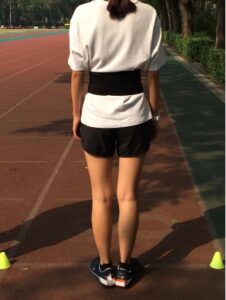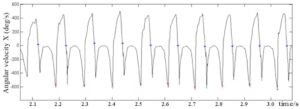By Yuge Zhang.
Epidemiological research shows that approximately 30% of community-living people aged 65 years and over fall at least once a year. Among them, women appear more likely to fall, with studies reporting that approximately 65% of women fall in their usual place of residence compared to only 44% of men. Portable and cheap inertial sensors has been proved to be a feasible way to quantify collect gait data in people’s own environment on either the trunk or foot. Our aim was to further understand gait differences between young and older women in gait acceleration intensity, variability and stability of the feet and trunk using inertial sensors.
We recruited 20 older women (mean age 68 years) and 18 young women (mean age 22) to walk straight for 100 meters at their preferred speed, while wearing inertial sensors on their heels and lower back (See Figure 1). Since previous research has shown that clinical gait tests of 4 or 10 meters do not represent daily-life gait very well, we asked people to walk 100 meters to reflect well the natural gait without participants being exhausted. We used sagittal plane angular velocity of foot sensor to classify gait events, time of heel strike and toe off (See Figure 2). We found that foot maximum vertical acceleration and amplitude, trunk-foot vertical acceleration attenuation, as well as their variability were significantly smaller in older compared to young women. In contrast, trunk mediolateral acceleration amplitude, maximum vertical acceleration, and amplitude, as well as their variability were significantly larger in older compared to young women. Moreover, older women showed lower stability (i.e., higher LDE values) in mediolateral acceleration as well as lower mediolateral and vertical angular velocities of the trunk.
Even though we measured healthy older women, they had softer floor impacts with higher vertical trunk acceleration, lower attenuation between trunk-foot vertical acceleration, and higher variability of the trunk acceleration, and hence, were more likely to fall. These findings suggest that instrumented gait measurements may help for the early detection of changes or impairments in gait performance.

Figure 1. Test environment

Figure 2. Sagittal plane angular velocity of foot sensor (The blue and red points represented the gait events Theel_strike and Tfoot-flat, respectively)
Publication
Yuge Zhang, Xinglong Zhou, Mirjam Pijnappels, Sjoerd M. Bruijn. Differences in gait stability and acceleration characteristics between healthy young and older females. Frontiers in rehabilitation sciences, 2021. DOI: 10.3389/fresc.2021.763309.
About the Author

Yuge Zhang
PhD student at Vrije Universiteit Amsterdam
Yuge Zhang is a PhD student at Vrije Universiteit Amsterdam. Her main research topic is fall prevention in older people, using techniques to analyze gait based on inertial sensors.
Copyright
© 2021 by the author. Except as otherwise noted, the ISPGR blog, including its text and figures, is licensed under a Creative Commons Attribution-ShareAlike 4.0 International License. To view a copy of this license, visit https://creativecommons.org/licenses/by-sa/4.0/legalcode.
ISPGR blog (ISSN 2561-4703)
Are you interested in writing a blog post for the ISPGR website? If so, please email the ISGPR Secretariat with the following information:
- First and Last Name
- Institution/Affiliation
- Paper you will be referencing



